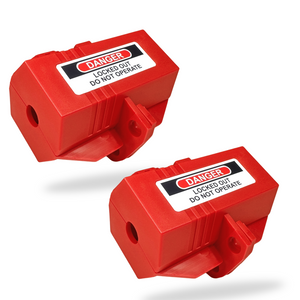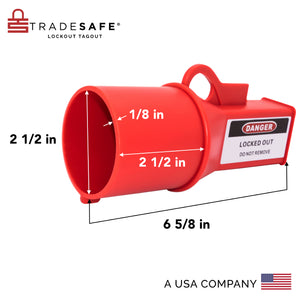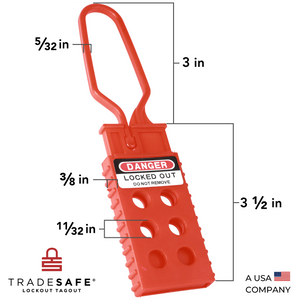-
-75%


Oversized Plug and Hoist Control Cover, Fits 18” Controls
Regular price $24.95Regular price$100.00-75%Sale price $24.95 -
-27%


Lockout Tagout Tool Box Kit - 85 LOTO Devices
Regular price $239.95Regular price$329.95-27%Sale price $239.95 -
-26%


Valve Lockout Tagout Kit - 55 LOTO Devices
Regular price $319.95Regular price$429.95-26%Sale price $319.95 -
-25%


Complete Electrical Lockout Tagout Kit - 90 LOTO Devices
Regular price $299.95Regular price$399.95-25%Sale price $299.95 -
-20%


Ultimate Lockout Tagout Kit - 95 LOTO Devices
Regular price $439.95Regular price$549.95-20%Sale price $439.95 -
-54%


Electrical Lockout Tagout Kit – 1 Key Per Lock
Regular price $68.95Regular price$149.00-54%Sale price $68.95 -
-54%


Electrical Lockout Tagout Kit – 2 Keys Per Lock
Regular price $68.95Regular price$149.00-54%Sale price $68.95 -
-62%


Complete Breaker Lockout Tagout Kit – 1 Key Per Lock
Regular price $79.90Regular price$209.00-62%Sale price $79.90 -
-62%


Complete Breaker Lockout Tagout Kit – 2 Keys Per Lock
Regular price $79.90Regular price$209.00-62%Sale price $79.90 -
-56%


Professional Lockout Tagout Kit – 2 Keys Per Lock
Regular price $84.95Regular price$193.00-56%Sale price $84.95 -
-56%


Professional Lockout Tagout Kit – 1 Key Per Lock
Regular price $84.95Regular price$193.00-56%Sale price $84.95 -
-62%


Personal Lockout Tagout Kit – 1 Key Per Lock
Regular price $41.95Regular price$110.00-62%Sale price $41.95 -
-62%


Personal Lockout Tagout Kit – 2 Keys Per Lock
Regular price $41.95Regular price$110.00-62%Sale price $41.95 -
-40%


Plug Lockout Device - 110V-125V - Small, 2 Pack
Regular price $14.95Regular price$24.95-40%Sale price $14.95 -
-44%


Plug Lockout Device - 110 to 125V - Medium
Regular price $13.95Regular price$24.95-44%Sale price $13.95 -
-48%


Plug Lockout Device - 110V-125V - Medium, 2 Pack
Regular price $25.95Regular price$50.00-48%Sale price $25.95 -
-37%


Plug Lockout Device - 220V - Large
Regular price $18.95Regular price$29.95-37%Sale price $18.95 -
-50%


Plug Lockout Device - 220V - Large, 2 Pack
Regular price $34.95Regular price$70.00-50%Sale price $34.95 -
-43%


Power Plug Lock Keyed Different - 5 Pack - 2 Keys Each
Regular price $84.95Regular price$150.00-43%Sale price $84.95 -
-43%


Power Plug Lock Keyed Alike Unlimited - 5 Pack - 2 Keys Each
Regular price $84.95Regular price$150.00-43%Sale price $84.95 -
-42%


Clamp-on Circuit Breaker Lockout Device – 120/277 Volt – 10 Pack
Regular price $69.95Regular price$120.00-42%Sale price $69.95 -
-53%


Clamp-on Circuit Breaker Lockout Device – 480/600 Volt – 3 Pack
Regular price $27.95Regular price$60.00-53%Sale price $27.95 -
-50%


Clamp-on Circuit Breaker Lockout Device – Oversized 480/600 Volt – 3 Pack
Regular price $34.95Regular price$70.00-50%Sale price $34.95 -
Sold out


Universal Circuit Breaker Lockout Device - up to 7/8" Tie Bar – 10 Pack
Regular price $78.95Regular price$130.00-39%Sale price $78.95 -
-29%


Miniature Circuit Breaker Lockout Device - Pin In Standard (PIS) - 3 Pack
Regular price $16.95Regular price$24.00-29%Sale price $16.95 -
-29%


Miniature Circuit Breaker Lockout Device - Pin Out Standard (POS) - 3 Pack
Regular price $16.95Regular price$24.00-29%Sale price $16.95 -
-29%


Miniature Circuit Breaker Lockout Device - Pin Out Wide (POW) - 3 Pack
Regular price $16.95Regular price$24.00-29%Sale price $16.95 -
-29%


Miniature Circuit Breaker Lockout Device - Tie Bar Lockout (TBLO) - 3 Pack
Regular price $16.95Regular price$24.00-29%Sale price $16.95 -
-40%


Circuit Breaker Lockout – Breaker Blocker Kit – 480/600 Volt
Regular price $29.95Regular price$50.00-40%Sale price $29.95 -
-70%


Medium Push Button Lockout – Round – 5 Pack
Regular price $35.80Regular price$120.00-70%Sale price $35.80 -
-64%


Large Push Button Lockout – Round – 5 Pack
Regular price $43.80Regular price$120.00-64%Sale price $43.80 -
-49%


Push Button Lockout - Round - 3-Piece Set
Regular price $29.95Regular price$59.00-49%Sale price $29.95 -
-49%


Push Button Lockout - Box Type - Medium
Regular price $29.95Regular price$59.00-49%Sale price $29.95 -
-49%


Push Button Lockout - Box Type - Large
Regular price $39.95Regular price$79.00-49%Sale price $39.95 -
-49%


Push Button Lockout - Box Type - XL
Regular price $44.95Regular price$89.00-49%Sale price $44.95 -
-49%


Pin and Sleeve Socket Lockout Device – 1 1/2” Diameter
Regular price $19.95Regular price$39.00-49%Sale price $19.95 -
-49%


Pin and Sleeve Socket Lockout Device – 2” Diameter
Regular price $19.95Regular price$39.00-49%Sale price $19.95 -
-49%


Pin and Sleeve Socket Lockout Device – 2-1/4” Diameter
Regular price $24.95Regular price$49.00-49%Sale price $24.95 -
-49%


Pin and Sleeve Socket Lockout Device – 2-1/2” Diameter
Regular price $24.95Regular price$49.00-49%Sale price $24.95 -
-39%


Pin and Sleeve Socket Lockout Device – 2-7/8” Diameter
Regular price $29.95Regular price$49.00-39%Sale price $29.95 -
-61%


Lockout Tagout Hasp with 6 Padlock Holes – Polypropylene – 3 Pack
Regular price $14.95Regular price$38.00-61%Sale price $14.95 -
-47%


Lockout Tagout Hasp – Nylon and Steel, 1" Jaw Diameter, 6 Pack
Regular price $35.95Regular price$68.00-47%Sale price $35.95 -
-42%


Lockout Tagout Hasp – Nylon and Steel, 1-1/2" Jaw Diameter, 6 Pack
Regular price $45.95Regular price$79.00-42%Sale price $45.95 -
-30%


Lockout Tagout Danger Tags – Pack of 10
Regular price $20.95Regular price$30.00-30%Sale price $20.95 -
-38%


Lockout Tagout Danger Tags – Pack of 30
Regular price $36.95Regular price$60.00-38%Sale price $36.95 -
-45%


Lockout Tagout Danger Tags – Pack of 60
Regular price $65.95Regular price$120.00-45%Sale price $65.95 -
-38%


Bilingual Lockout Tagout Danger Tags – Pack of 30
Regular price $36.95Regular price$60.00-38%Sale price $36.95 -
-38%


Spanish Lockout Tagout Danger Tags – Pack of 30
Regular price $36.95Regular price$60.00-38%Sale price $36.95
Electrical lockout devices are an important component of your safety practices for keeping your workplace safe and OSHA-compliant. It protects workers from uncontrolled hazardous energy that may escape from machinery or equipment during isolation, servicing, or maintenance.
At TRADESAFE, safety is never compromised but maximized. Our collection includes a wide range of electrical lockouts available to fit plugs & sockets, valves, panels, breakers, and more. Each electrical lockout device is easy to use and made of high-quality materials that can resist the harsh and hazardous environments common in industrial facilities.
TRADESAFE only offers premium, precision-engineered lockout devices to help you meet OSHA 1910.147 (Control of Hazardous Energy) standards in your workplace while also instilling responsibility and accountability among your workers.
































































































